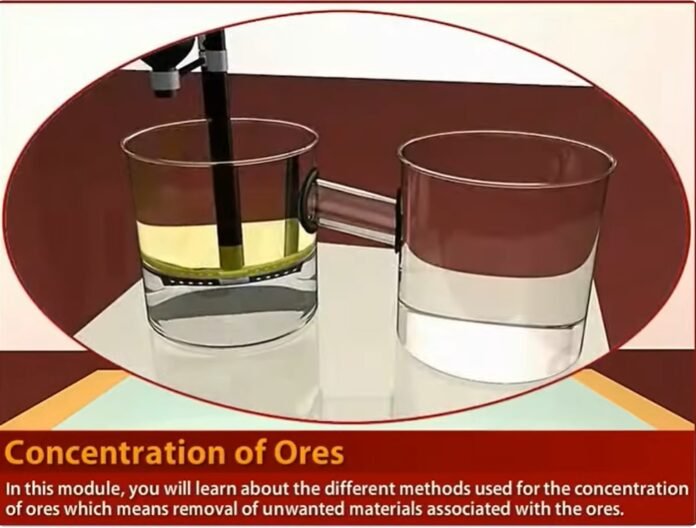When combined with other elements, metals can be found in an ore as compounds. The process of removing metal from its ore is called metal extraction. Metallurgy refers to the processes of obtaining metals from their ores and purifying them.
Introduction
No single method can be used to extract all of the metals. Depending on the metal, different techniques need to be followed. One of the most crucial phases in extracting metal from its ore is the concentration of ore, also known as the enrichment of ore.
What is an ore?
Ore is a solid material that contains one or more minerals and is used to recover metal through processes like concentration, refining, and isolation. Metals like copper, gold, and iron are found in crucial ore deposits that are important for industries and trade. To extract metal profitably, the ore must have a high percentage of metal and be free of any undesirable contaminants. However, ores also contain impurities or unwanted minerals, known as “gangue,” such as sand and rock. Before metal can be recovered from the ore, gangue must be removed.
What is Concentration of Ore?
Ores are concentrated by removing undesired particles, such as gangue, based on their type and percentage. Concentrating ore increases the metal content, which is known as ore enrichment. The removal of impurities is done through physical or chemical methods, based on the differences in the properties of the ore and impurities. This initial step is crucial in metallurgy to produce ore with a higher metal percentage. Techniques like hydraulic washing, magnetic separation, froth flotation, and leaching are used to separate gangue and ore. The specific method used depends on the physical and chemical properties of the gangue and ore.
Hydraulic Washing
The lighter gangue particles are separated from the heavier metal ore when the ore is passed through an upward water stream. This separation technique uses gravity. Ores that are heavier than the gangue particles present in them are enriched using this technique. In this process, ore that has been crushed and finely powdered is passed through a stream of water. The larger ore particles are left behind after the lighter gangue particles are washed away by water. Tin and lead oxide ores are concentrated using this method.
Magnetic Separation
Magnetic properties of either the ore or the gangue are utilized to separate the ore and gangue. Prior to being transported on a conveyor belt that travels through a magnetic roller, the ore is first finely processed. Gangue slips off the belt while the magnetic ore remains on it. This procedure is used to concentrate magnetic iron ores such as magnetite, chromite, and manganese (pyrolusite) by removing non-magnetic impurities. In this process, a magnetic separator is used. A leather belt and two rollers make up a magnetic separator. Among the two rollers, one has a magnet incorporated into it. This involves dropping the finely powdered magnetic ore over the moving belt at one end. When the powdered ore falls down from the moving belt at the other end using a magnetic roller, the ore particles are drawn to the magnet and form a distinct heap from the non-magnetic impurities.
Froth Flotation
Froth flotation is used to remove gangue from sulfide ores. Pulverized ore is mixed with water to make a suspension, to which froth stabilizers and collectors are added.
- Collectors like pine oils and fatty acids make the metal component less wettable, which causes it to froth up. Stabilizers like cresols and aniline maintain the foam, while water lubricates gangue and oil lubricates metal.
- The suspension is agitated with air to create foam. The frothy metal is skimmed off the top and dried to retrieve the metal. Copper, lead, and zinc sulfide ores are concentrated using this method.
- Pine oil is added to the water-filled tank with powdered ore. Gangue particles are wetted with water, while sulfide ore particles are moistened with pine oil. The mixture is aired, causing the sulfide ore particles to rise to the surface as froth and gangue particles sink to the bottom. Concentrated sulfide ore is extracted from the separated froth.
Leaching
Leaching is an appropriate method if the contaminants are insoluble in the chemical solvent but the ore is soluble. The undissolved contaminants can be washed off when the ore particle is transformed into a soluble salt of the solvent.
- Tailing is the term for leftover materials. One of the techniques for ore concentration is leaching. Here, the ore undergoes chemical treatment to create a soluble salt. However, since contaminants cannot be dissolved in the chemical, it remains unchanged.
- Metal can be removed from the solution after processing. Leaching using pyrometallurgy, in contrast, uses a lot less money and energy. Extreme pressure and temperature are not required for it. Leaching also allows for the extraction of a significant amount of metals compared to conventional concentration techniques.
Recommended Articles:
Compton Wavelength: Introduction, Equation, Importance, And Effect
Concave And Convex Mirrors Spherical Mirrors
Concave Convex Lenses: Introduction, Difference, And Applications
Concave Mirror And Convex Mirror: Introduction, Types, Difference, And Applications
Concave lens: Introduction, Terminology, Image, And Application
A chemical process for concentrating ores is called leaching. The concentration of ore for lead oxide ores is accomplished using hydraulic washing. Because it is considerably simpler to extract a metal once the impurities have been eliminated and hence, and the concentration of ore is essential. Leaching is used to concentrate low-grade copper ore, gold ore, silver ore, and aluminum ore. Concentration of Ore FAQs
What is the chemical method of concentration of ore?
Which technique is used for concentrating lead oxide ores?
What role does ore concentration play?
What kind of metal is extracted during leaching?
